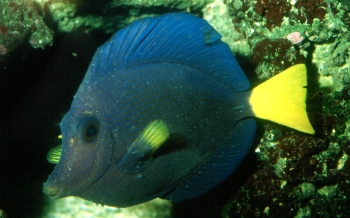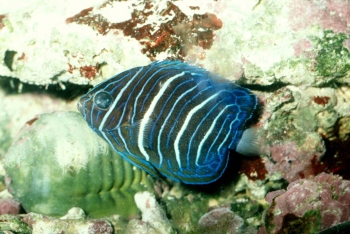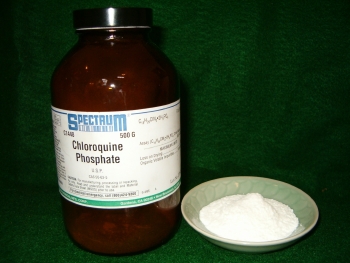
By Bob Goemans

Marine aquarists have for decades been troubled with three very common maladies, i.e., Cryptocaryon irritans (Marine Ich, White Spot Disease); Amyloodinium ocellatum (Velvet/Coral Fish Disease); and, Brooklynella hostilis (Clownfish Disease).
These troublesome single-cell organisms possess either flagella (whip-like appendages) or hair–like cilia that are used for locomotion and/or feeding. It appears many of these parasites are ubiquitous, and almost always present either on existing fish in numbers not radically affecting them, or in aquarium organic debris awaiting a ‘window of opportunity’ to increase their numbers. Also, once these parasites reach the swimming stage, can be transmitted from tank to tank by infected nets or wet hands.
The effects of stress, such as what is caused by poor water quality, poor nutrition, radical temperature fluctuations, hostile tankmates, etc., often results in a lowered resistance, permitting parasites such as these already existing in the aquarium to find a beleaguered host no longer capable of warding them off or controlling their numbers, and then reproducing to epidemic proportions.
These parasites primarily affect the skin, fins, eyes and gill tissue. As a result, rapid breathing, as well as flashing are common developing symptoms. They often create openings in the slime coat and epithelium (skin) whereby more dangerous pathogens can enter as well, such as bacteria. Nevertheless, it should be clear that stress in itself does not cause diseases to occur, as it merely compromises the fish’s immune system, lowering its resistance and immune response to disease organisms that may already be present in the system.
With that said, lets briefly look first at each of the above mentioned maladies, their symptoms and generally recommended treatments, then conclude with a new treatment for all three that is promising a bright outlook for these troublesome maladies, whether treatment occurs in fish-only or reef aquariums. In fact, freshwater ‘ich’ (Ichthyophthirius multifilis) is now also treatable using the chemical compound discussed further below!
Cryptocaryon is probably the most common disease encountered by marine fish enthusiasts. These ciliates bore under the fish's epithelium, causing a build-up of skin and slime. This often results in a whitish appearance, giving it the familiar name of White Spot Disease. Its life cycle can extend upwards of 28 days or more and undergoes three stages: 1) the trophont stage, 2) the tomont stage, and 3) the tomite stage. The trophont stage is the period when the parasites are imbedded in the fish's skin, also known as the feeding stage. The tomont stage is the stage when the parasites have fallen off the host and have encysted to reproduce, also known as the dividing stage. Finally, after many days, the cyst breaks open and tomites are released in swarms as the newly hatched parasites seek new hosts. Since the parasite is either under the skin of the fish or encysted during the first two stages, it is only during this final swarming stage that medications such as Copper or Formalin can actually kill the parasite.

In fish-only tanks, hyposalinity conditions, i.e., a Specific Gravity (S.G.) of 1.010 to 1.013 should be established as first aid, if at all possible. However, bear in mind that since a density above 1.013 is not therapeutic, it has no effect on the parasite, so the margin of efficacy of hyposalinity is quite small. Combined with hyposalinity, an ionic Copper Sulfate solution utilized at a concentration of 0.18 to 0.20 ppm for a minimum of 28 days in duration so as to encompass the entire life cycle of the parasite is quite effective. Additionally, it has been reported that Copper Sulfate in combination with Formalin/Malachite Green has shown more effectiveness than Copper Sulfate alone (Bassleer, 1996).
Finally, although many sources from the past recommended raising the aquarium temperature to 85°F or so, we do not. Even though this may work for freshwater Ich by preventing the uptake of oxygen through the cell membrane, it serves to stress the saltwater Ich to the point the parasite will encyst and go dormant. It will remain encysted until such time as the temperature is returned to normal at which time it will seek a new host, reinfesting the aquarium (G. Blasiola, pers. dis.). Actually, we have seen Cryptocaryon lay dormant in a reef aquarium for over 90 days only to reinfest newly introduced fish which had been in quarantine for over 60 days prior. Therefore, we recommend that you leave the temperature at the normal level, e.g., approximately 76 - 78°F and refrain from changing it during treatment.
In reef aquaria, the infested fish need to be removed and placed in a suitable environment without any invertebrates for treatment. Often a most difficult situation to adequately accomplish!
Another common disease is caused by the dinoflagellate Amyloodinium ocellatum. This parasite is actually an algal protozoan and possesses a life cycle comprised of three stages. They are: 1) the parasitic trophont stage, 2) the encysted, or palmella stage (tomont stage), and 3) the dinospore stage (Gratzek, Wolke, Shotts, Dawe, & Blasiola, 1992). While in the trophont stage, the parasite can be found on the host fish absorbing nutrients for its reproduction and is non-motile. During the encysted or palmella (tomont) stage, the parasite can be seen dividing while still on the fish. This is the reproductive portion of its life cycle. Finally, as a dinospore the newly hatched parasite has emerged from its cyst and is either free-swimming or looking for a new host or has just recently found a new host.

Affected fish appear as though they have been rolled in powdered sugar. This also can appear velvet-like, thus the name Velvet Disease. Because of its small size (50 - 60 microns), Amyloodinium will dust fins, skin, and eyes making these areas appear cloudy or turbid. Fish in advanced stages will excessively slough the protective slime coating, similar to other parasitic infestations (Bassleer, 1996). These parasites affect all external areas of the fish and are capable of doing extensive damage to the gill tissue, causing rapid gill movement. This damage results in difficulty obtaining oxygen, as well as problems in excreting waste. And due to irritation of the skin and gills, fish may be seen flashing (rubbing against aquarium décor) or scraping their bodies and gill plates on bottom substrate or other decorations within the aquarium.
Freshwater baths are somewhat recommended if easily removed from the aquarium, yet whether its administered or not, treatment of the aquarium (fish-only of course) with ionic Copper Sulfate at 0.18 to 0.20 ppm for three to four weeks will usually eliminate this disease. It should be mentioned that many times a hobbyist will end the treatment too soon, as is the case with Cryptocaryon and after a few days of apparent cure, the parasite will reappear and infect fish once again. It has also been reported that dinospores may live without a host for an extended period of time (in excess of three to four weeks). Therefore, it might be wise to continue treatment for at least 10 days after the last signs of the parasite has been observed (Clifton, 1993).
During treatment we highly recommend the S.G. of the aquarium (hyposalinity) be lowered. Although some authors recommend lowering the S.G. slowly, we suggest a radical and immediate drop in S.G. as low as 1.010 - 1.013 (T. Frakes, pers. dis.; G. Blasiola, pers. dis.; pers. obs.). We have not seen any ill effects to the fish by dropping the salt content in this manner. We have, however, seen dramatic results in controlling the parasite due to the fact that they are not osmoregulatory. Because of this fact, the parasite cannot control the osmosis through their semi-permeable membrane. Therefore they begin to absorb water in an effort to equalize the osmotic pressures within and outside of their cell wall. As a result they eventually explode when their cell wall can no longer maintain the pressure of the water they absorb, similar to a water balloon filled with too much water.
However, when the treatment period has ended be sure to raise the S.G. slowly, as we have seen osmotic shock and imbalances as a result of raising the salt content too quickly. We recommend an adjustment of no more than .002 per 24 hours when bringing the salt content back up. For example - if the S.G. is 1.010, raise it no more than up to 1.012 in the first day, then from 1.012 to 1.014 the following day, etc. For obvious reasons this procedure and medications such as Copper Sulfate should never be applied in an aquarium containing invertebrates as such a procedure will prove detrimental or lethal to invertebrates.
Clownfish or Anemonefish Disease caused by the ciliated protozoan, Brooklynella hostilis seems to be quite virulent since its simple cell division occurs very quickly (Bassleer, 1996). Typically, this disease will enter an aquarium on a previously infected fish. As the name indicates, Clownfish, as well as Seahorses, are exceptionally susceptible to this malady. However, it appears to affect all marine fish as we have isolated it from fish of all families with the exception of elasmobranchs (Sharks and Rays). Fish of greatest risk appear to be ones living in over-crowded conditions and/or with poor water quality (Gratzek, Wolke, Shotts, Dawe & Blasiola 1992; Untergasser, 1989).
There has not been a description of particular stages of its life cycle as in the case of the above two maladies. This parasite simply divides right on the host and matures, as well as daughter cells spreading to other fish directly. The parasite feeds on skin and blood cells of its host and due to the potential for great numbers of parasites, causes serious and extensive damage to skin, gills, and fin tissue. Because of the great potential for damage, death usually occurs quite rapidly, typically as a result of fluid loss, dehydration and possible secondary bacterial infection, in that order.
Initially, there appears to be no outward signs of this disease, although small whitish spots may become visible on skin and fin tissue. Within a short period of time the aquarist will be able to see rapid gill movement, as the parasite will initially affect the gills by causing damage to the epithelial layers and lamellae making breathing difficult. Soon thereafter a characteristic patchy appearance will be visible on external areas of the skin, caused by a build-up or thickening of the slime coat in various areas of the body affected by the parasites. There will then be turbidity (cloudiness) of skin, fins and eye tissue. As the slime coat thickens, a general sloughing of the slime will occur, sometimes appearing as slimy strings hanging off the body.
Over time, fish will begin to flash on objects, lose their appetite, display labored breathing, exhibit a shimmying behavior and eventually lay on the bottom. Severe infestations may cause skin lesions to appear, acting as sites for dehydration, as well as secondary bacterial infections to occur. Bacterial infections may also lead to fin and tail rot.
Once again, hyposalinity conditions as first aid have shown good results in treating Brooklynella outbreaks (pers. obs.) since the parasite is not osmoregulatory, thereby having no control over its osmosis. This is why many authors, such as Nelson Herwig, George Blasiola, Martin Moe and Gerald Bassleer recommend freshwater baths (at least for the stronger specimens) to help reduce the number of parasites present. Most authors agree that the drug of choice in combating a Brooklynella outbreak is a Formalin or Formalin/Malachite Green solution, although we have had good success in the past with ionic Copper Sulfate at 0.18 - 0.20 ppm for 28 days when combined with hyposalinity conditions.
Nevertheless, as with all three maladies mentioned above, a decision must be made where the affected fish can be treated along with the impact the medications will have on system filtration. It now appears these medications can be considered ‘outdated’ and our fish treated quite successfully in either fish-only or reef aquariums with an alternative product, with no harm to filtration bacterium! This product is called ‘Chloroquine phosphate’ or Aralen®. Similar to Quinine hydrochloride, Chloroquine is an antimalarial drug, and also like Quinine, has similar effectiveness in the eradication of protozoan parasites. The product is available from various chemical supply houses and requires no special license or permit for its purchase. However, as with anything new, it takes time to prove-out the procedures associated with the use of the product.
This product got our attention when it was briefly mentioned in Fish Disease, Diagnosis and Treatment (Noga, 2000), and further research led to finding some public aquariums experimenting with it and having very good success treating the above-mentioned maladies, including Uronema. Early experiments with the product showed that while much safer and less toxic than other traditional treatments of the past, it did have a negative effect on alga. Therefore, aquarium alga and invertebrates containing zooxanthellae were at risk, which we witnessed firsthand in some early experiments, where some soft and stony corals perished. Nevertheless, Richard Terrell of the Pittsburg Zoo Aquarium & PPG Aquarium has reported using Chloroquine-dosed gel foods to halt an outbreak of Cryptocaryon in a giant clam exhibit, with excellent results.

Unfortunately, there is not sufficient space remaining here to describe product usage/dosage recommendations and availability, or those we have worked with and their and our results to bring this medication forth to the general public. If desiring more information, contact us through FAMA or read our new book titled “Marine Fish Health and Feeding Handbook” (Microcosm 2007), where the product is more widely discussed, along with other maladies and fish nutrition.